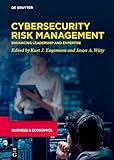Developments in Managing and Exploiting Risk. Volume V, Cybersecurity Risk Management ; Enhancing Leadership and Expertise / ed. by Kurt J. Engemann, Jason A. Witty.
Material type: TextSeries: Developments in Managing and Exploiting Risk ; Volume VPublisher: Berlin ; Boston : De Gruyter, [2024]Copyright date: 2024Description: 1 online resource (XIV, 257 p.)Content type:
TextSeries: Developments in Managing and Exploiting Risk ; Volume VPublisher: Berlin ; Boston : De Gruyter, [2024]Copyright date: 2024Description: 1 online resource (XIV, 257 p.)Content type: - 9783111286013
- 9783111289601
- 9783111289069
- 005.8
- online - DeGruyter
- Issued also in print.
| Item type | Current library | Call number | URL | Status | Notes | Barcode | |
|---|---|---|---|---|---|---|---|
 eBook
eBook
|
Biblioteca "Angelicum" Pont. Univ. S.Tommaso d'Aquino Nuvola online | online - DeGruyter (Browse shelf(Opens below)) | Online access | Not for loan (Accesso limitato) | Accesso per gli utenti autorizzati / Access for authorized users | (dgr)9783111289069 |
Frontmatter -- Advances in cybersecurity risk management -- Contents -- Part I: Fundamentals -- 1 Introduction to and brief history of cybersecurity risk management -- 2 Hierarchical considerations in cyber risk assessments: Strategic versus operational prioritization in managing current and emergent threats -- 3 The benefits of human factors engineering in cybersecurity -- 4 An organizational climate primer for the development of cybersecurity socio-organizational frameworks -- 5 Transparent and inclusive cybersecurity risk management and governance -- 6 Securing artificial intelligence in the real world -- Part II: Applications -- 7 The CISO evolution and impact on goals, processes, and priorities -- 8 Towards a more secure IT driven future: The necessity and promise of IT operations management governance -- 9 Practical cyber risk management – preventing the predictable: Drivers of decision making under risk -- 10 Implications of artificial intelligence in cybersecurity for individuals -- 11 Ensuring transportation cybersecurity: Air, auto, and rail -- 12 Towards robust policy frameworks for securing cyber-physical systems in healthcare -- Contributors -- Index -- Developments in managing and exploiting risk
restricted access online access with authorization star
http://purl.org/coar/access_right/c_16ec
Cybersecurity refers to the set of technologies, practices, and strategies designed to protect computer systems, networks, devices, and data from unauthorized access, theft, damage, disruption, or misuse. It involves identifying and assessing potential threats and vulnerabilities, and implementing controls and countermeasures to prevent or mitigate them. Some major risks of a successful cyberattack include: data breaches, ransomware attacks, disruption of services, damage to infrastructure, espionage and sabotage. Cybersecurity Risk Management: Enhancing Leadership and Expertise explores this highly dynamic field that is situated in a fascinating juxtaposition with an extremely advanced and capable set of cyber threat adversaries, rapidly evolving technologies, global digitalization, complex international rules and regulations, geo-politics, and even warfare. A successful cyber-attack can have significant consequences for individuals, organizations, and society as a whole. With comprehensive chapters in the first part of the book covering fundamental concepts and approaches, and those in the second illustrating applications of these fundamental principles, Cybersecurity Risk Management: Enhancing Leadership and Expertise makes an important contribution to the literature in the field by proposing an appropriate basis for managing cybersecurity risk to overcome practical challenges.
Issued also in print.
Mode of access: Internet via World Wide Web.
In English.
Description based on online resource; title from PDF title page (publisher's Web site, viewed 20. Nov 2024)


